Destinations in India
Free Consultation
Choice of Destinations:
In our endeavor to offer the best possible solution to your medical needs, our team has explored the various destinations which offer benefits on any of the following parameters, needless to mention that the quality standards remain the same at all the selected locations.
We offer a wide choice of destinations The selection of the places has been done on the basis of cost benefit in terms of affordability and availabity of accommodation, transport and environment for recuperation. Needless to mention, the standard of quality of treatment remains the same.
About Delhi:
Delhi, locally pronounced as Dilli or Dehli, officially National Capital Territory of Delhi (NCT), is the largest metropolis by area and the second-largest city by population in India. Located on the banks of the River Yamuna, The Delhi has been known to be continuously inhabited since at least the 6th century BC, though human habitation is believed to have existed since the second millennium BC. It is the site of many ancient and medieval monuments, archaeological sites and remains. The city’s importance lies not just in its past glory as the seat of empires and magnificent monuments, but also in the rich and diverse cultures.
Places to Visit:
There are a number of places to see in Delhi city of India. Besides the majestic forts and monuments, the capital city of India houses several other attractions that lure the tourists.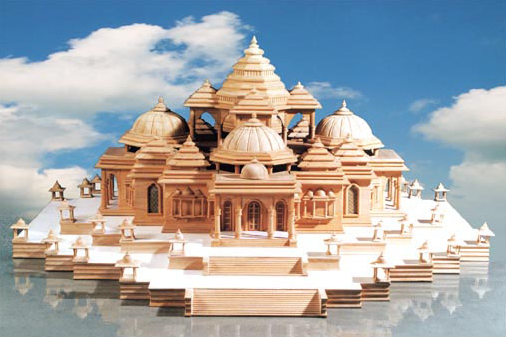
Akshardham Temple is a magnificent Hindu shrine, situated in the east region of New Delhi. Located on the banks of River Yamuna, it was inaugurated in November 2005, by the former President of India – APJ Abdul Kalam, the Prime Minister Manmohan Singh and Pramukh Swami Maharaj – the spiritual leader of BAPS.
Chandni Chowk
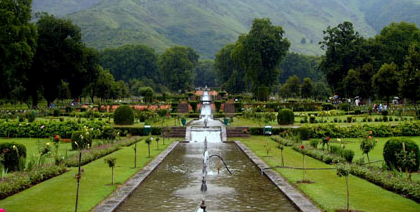
The antiquity of the main market area of Chandni Chowk has rendered it a venerated place in the markets of Delhi. It is said that it was once lined with beautiful fountains. However, with time, it grew as crowded as it is today.
Old Delhi
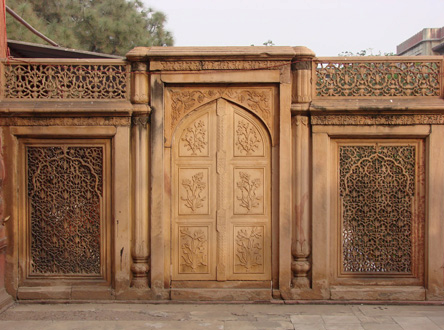
Old Delhi was once known as the city of Shahjahanabad. Shah Jahan established it and made it his capital. This fortified city has a long and interesting history and even today, the remains of its glorious past can be seen in the form of Kashmiri Gate, Ajmeri Gate, Turkman Gate, Delhi Gate and Feroz Shah Kotla.
Old Delhi

Old Delhi was once known as the city of Shahjahanabad. Shah Jahan established it and made it his capital. This fortified city has a long and interesting history and even today, the remains of its glorious past can be seen in the form of Kashmiri Gate, Ajmeri Gate, Turkman Gate, Delhi Gate and Feroz Shah Kotla.
India Gate
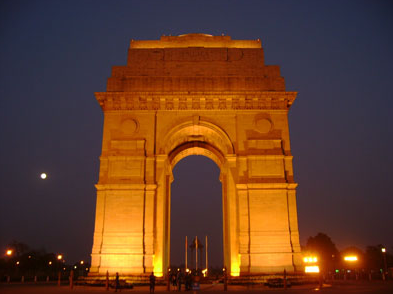
The war memorial arch, India Gate, was built by the British in the honor of the unknown martyrs, who lost their lives in the First World War and Second Afghan War. Vijay Chowk (the Victory Square) is the site of ‘Beating the Retreat’ ceremony held annually in New Delhi, on 29th January.
Raj Ghat
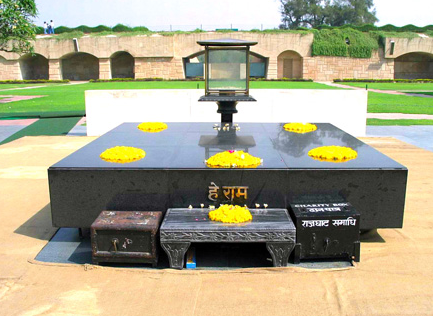
Raj Ghat, the cremation site of Mahatma Gandhi is one of the most visited sites in Delhi. It consists of a simple square black-marble platform that stands on the spot where Mahatma Gandhi was cremated. Nearby, there are cremation sites of Jawaharlal Nehru – the first Prime Minister of India, Indira Gandhi, Sanjay Gandhi, Rajiv Gandhi and Lal Bahadur Shastri.
Rashtrapati Bhawan
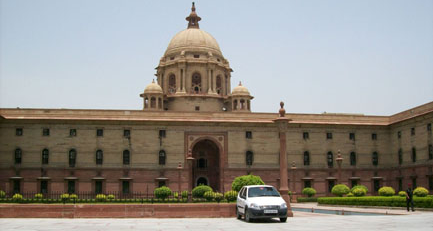
Rashtrapati Bhawan was formerly known as ‘Viceroy’s House’ and was occupied by the Governor-General of India, until independence. Also known as President’s House, the building holds a prominent position in New Delhi.
GETTING THERE:
Access by Air: Being the capital city of India New Delhi is well connected to all the major Indian cities through airways. Delhi has an international and domestic airport. It has regular flights to all the major Indian cities.
Access by Rail: Regular train services connect Delhi to all the major cities in India.
Access by Road: Delhi’s large network of roads and National Highway connects it to the major cities of India.
Climate:
Delhi features an atypical version of the humid subtropical climate. Summers are long and extremely hot, from early April to mid-October, with the monsoon season in between. Early March sees a reversal in the direction of wind, from the north-western direction, to the south-western. These bring the hot waves from Rajasthan, carrying sand and are a characteristic of the Delhi summer. The months of March to May see a time of hot prickling heat. Monsoon arrives at the end of June, bringing some respite from the heat, but increasing humidity at the same time. The brief, mild winter starts in late November and peaks in January and is notorious for its heavy fog.
About Mumbai:
Mumbai, formerly known as Bombay in English, is the capital of the Indian state of Maharashtra. It is the most populous city in India, and the sixth most populous city in the world. Mumbai lies on the west coast of India and has a deep natural harbour. As of 2009, Mumbai was named an Alpha world city. Mumbai is also the richest city in India, and has the highest GDP of any city in South, West or Central Asia. The seven islands that came to constitute Mumbai were home to communities of fishing colonies. Mumbai is the commercial and entertainment capital of India, it is also one of the world’s top 10 centres of commerce in terms of global financial flow, generating 5% of India’s GDP, and accounting for 25% of industrial output, 70% of maritime trade in India and 70% of capital transactions to India’s economy.
Places to Visit:
Mumbai is the city of Gold where one willing can achieve his dreams. People from all parts of the country come and try their luck here. This is the reason behind the cosmopolitan and mixed population of the city.
Colaba Area
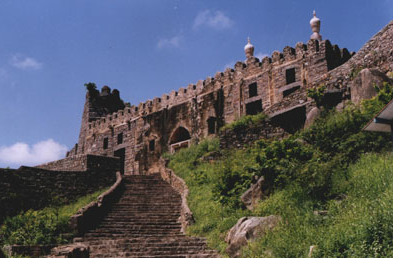
Situated in South-Bombay, this is a tourist preferred location. It has plenty of budget and mid-range hotels. The majestic Taj Mahal Hotel has great views of the Gateway of India from its top floor Apollo Bar.
Marine Drive
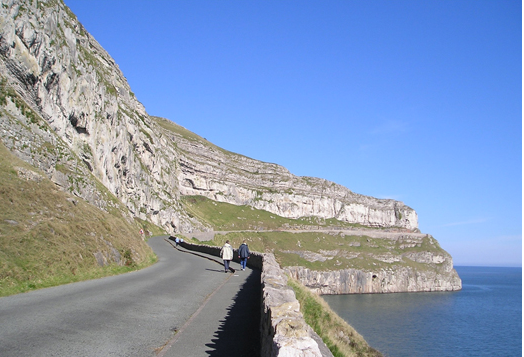
Built in 1920, Marine Drive runs along the shoreline of the Arabian Sea from Nariman Point to the foot of Malabar Hill. It passes Chowpatty Beach along the way. It’s one of Mumbai’s most popular romantic spot and sunset view is amazing. Tourist brochures are fond of stating it as the Queen’s Necklace, because of the dramatic curve of its streetlights at night.
Chowpatty Beach
Mumbai’s famous beach is no place for a sunbathe or taking a dip. In fact, there’s not much going on at Chowpatty at all during the day, but in the evening it develops a magical atmosphere as locals come to stroll among the balloon sellers, fortune tellers, magicians, nut vendors, ferris wheels and shooting galleries. You might even catch a film shoot or a street play.
Hanging Gardens
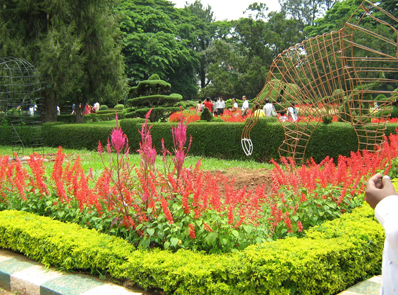
Perched at the top of Malabar Hill, on its western side, just opposite the Kamala Nehru Park, these terraced gardens, also known as Ferozeshah Mehta Gardens, provide lovely sunset views over the Arabian Sea. The park was laid out in the early 1880s over Bombay’s main reservoir, some say to cover the water from the potentially contaminating activity of the nearby Towers of Silence.
Gateway Of India
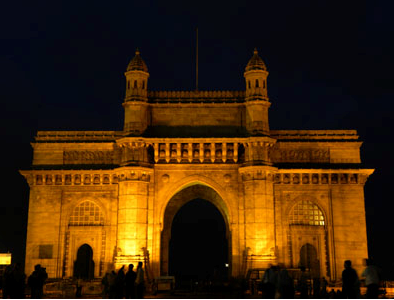
The Gateway of India – a 26 mt. Triumphal Archway designed Century to commemorate the visit of King Geoge and Queen Mary to India in 1911 – is Mumbai’s most famous landmark. Ironically, when the Raj ended in 1947, this colonial symbol also became a sort of epitaph: the last of the British ships that set sail for England left from the Gateway.
Haji Ali’s Mosque
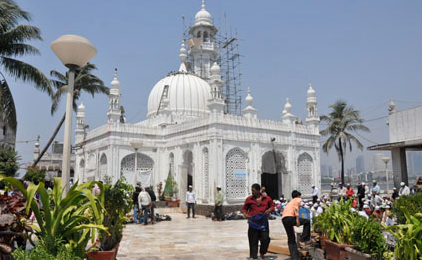
Situated in between the Arabian Sea, is a whitewashed fairytale mosque containing the tomb of the Muslim saint Haji Ali.
Film City
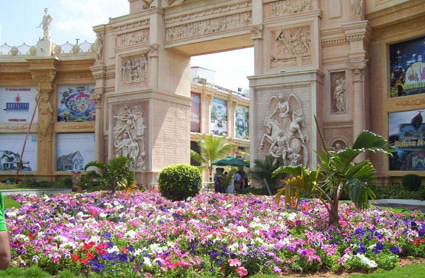
Mockingly called Bollywood by locals, Film City clings to the outskirts of the National Park, and is practically overrun by assorted stars and starlets — the demi gods and goddesses of modern India. Bollywood churns out over 900 films every year, all packed with those mandatory elements of song, dance, melodrama, violence and erotica that audiences love. Which is probably why Film City sets are heavily booked around the year. They are closed to visitors, but special permissions can always be obtained to check out the action.
Juhu Beach
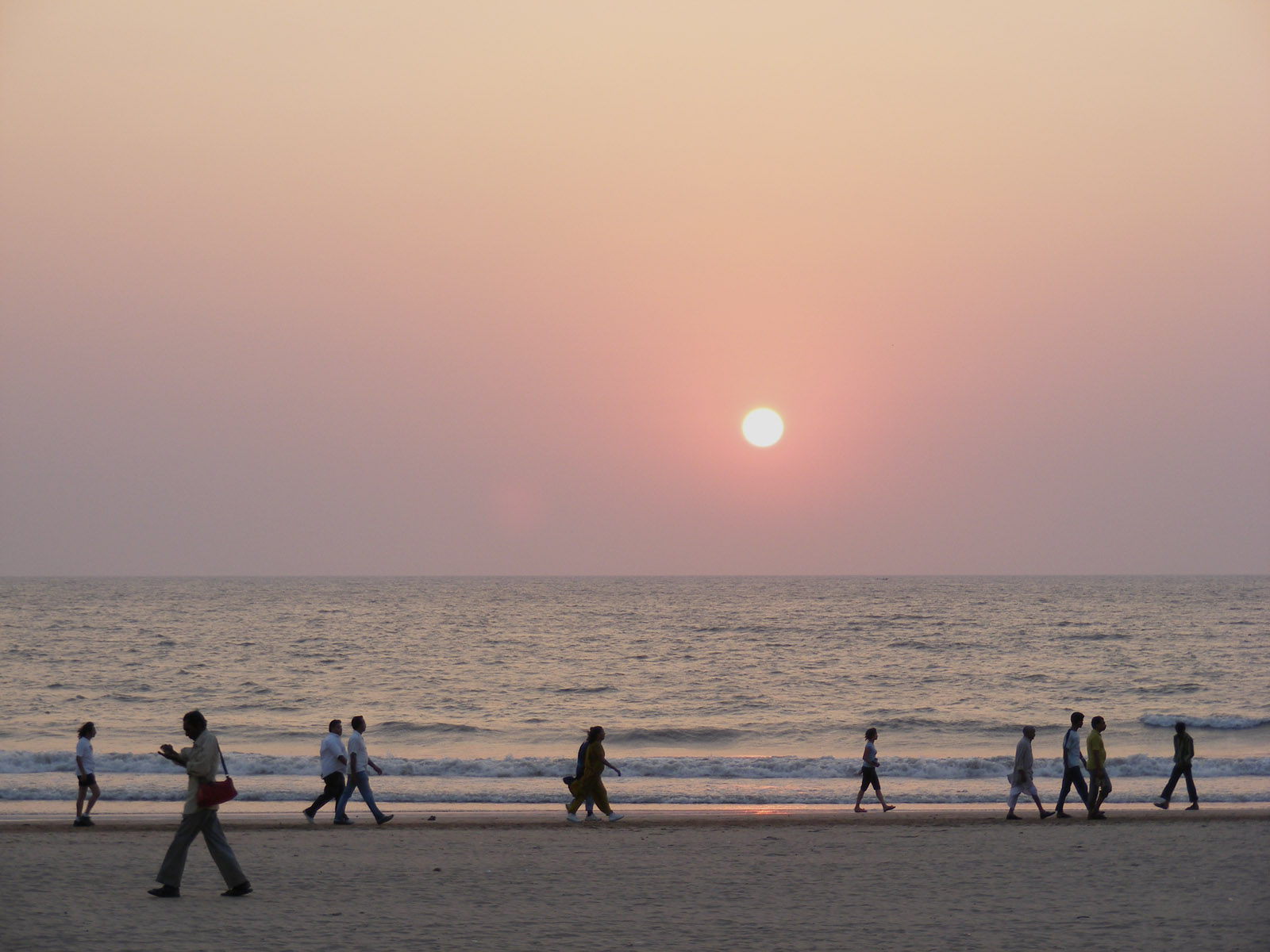
Like Chowpatty, its downtown counterpart, uptown Juhu Beach is also a bourgeois paradise, filled to the gills with screaming children, courting couples and rowdy adolescents. If you want a more fancy excursion, however, retreat behind Juhu’s many five star hotels, for a steaming cup of coffee and a splendid view of the coast. The most popular of these beachfront hotels are the Sun and Sand and Holiday Inn. The government run Juhu Centaur also has a 24 hour coffee shop with a view of the sea.
GETTING THERE:
Access by Air: Mumbai is well connected to the main Indian cities. It has regular flights to all the major Indian cities. The international Netaji Subhash Airport (Chatrapati Shivaji Airport) is 27 kms from the city. Most of the domestic airlines have direct services to and from Mumbai to other important cities of India such as Delhi, Kolkatta, Bangalore, Chennai, Patna, Varanasi, Lucknow, Goa, Cochin.
Access by Rail: Regular train services connect Kolkatta to all the major cities in India such as to Kolkatta in Eastern India, New Delhi in North India, Cochin in South India, Chennai in South East India etc.
Access by Road: Mumba’s National Highway connects it to the major cities of India. The National Highway connecting Kolkatta is superbly made with long driving and motels in between kept while upgrading the highway for the welfare of the drivers in mind.
Climate:
The Climate of Mumbai is a tropical wet and dry climate. Mumbai’s climate can be best described as moderate temperatures with high level of humidity. Its coastal nature and tropical location ensures moderate temperatures throughout the year, average of 27.2°C and average precipitation of 242.2 cm (95.35 inches). The temperatures in average about 30°C in summer and 18°C in winter. Mumbai’s experiences 4 distinct seasons Winter: (December-Feb); Summer: (March–May); Monsoon (June-Sep) and Post Monsoon (Oct-Dec).
About Goa:
Goa is India’s smallest state by area and the fourth smallest by population. Located in South West India in the region known as the Konkan, it is bounded by the state of Maharashtra to the north, and by Karnataka to the east and south, while the Arabian Sea forms its western coast. Goa is India’s richest state with a GDP per capita two and a half times that of the country as a whole. It was ranked the best placed state by the Eleventh Finance Commission for its infrastructure and ranked on top for the best quality of life in India by the National Commission on Population based on the 12 Indicators. Panaji is the state’s capital, while Vasco da Gama is the largest city. The historic city of Margao still exhibits the cultural influence of the Portuguese, who first landed in the early 16th century as merchants and conquered it soon thereafter. The Portuguese overseas territory of Portuguese India existed for about 450 years until it was annexed by India in 1961.
Places to Visit:
Goa is a dream destination in India and center of attraction for tourists. This state is famous for its majestic coastline making it the hub of some of the best beaches of the world.
Panjim – Capital City & Home to Best Places to Visit in North Goa
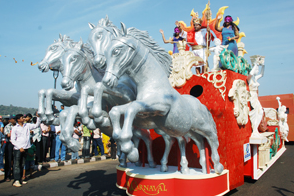
Panjim is the state capital of Goa and the administrative headquarter of North Goa District. This is a beautiful coastal town is adorned with churches and cathedrals and a string of beaches. Panjim’s biggest draw is the Carnival celebration in the month of February which includes a colorful parade on the city’s streets.
Old Goa – Houses UNESCO World Heritage Site Places in Goa
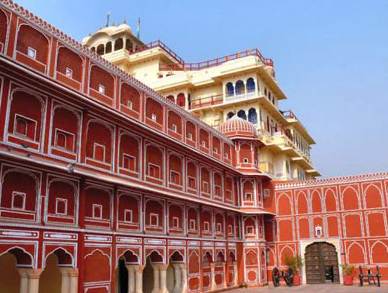
Old Goa is one of the important places to visit in Goa due to its historical significance. It was the former capital of Goa under the 350 years of Portuguese reign. It is an UNESCO declared World Heritage Site due to its Renaissance architecture which can be still witness in the monuments and churches of the region. A visit to Old Goa just cannot be missed out on your Goa visit.
Se Cathedral
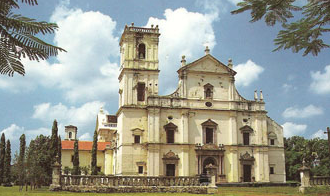
Churches are one of the most visited places to see in Goa, specially those located in Old Goa. Old Goa is actually a world heritage sites along with the various churches there. Amongst these churches is the Se Cathedral.
Margao – Explore the South Goa Places to See
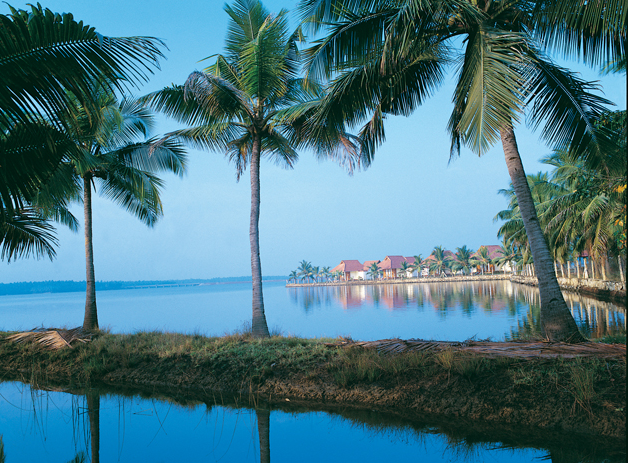
Margao is the second largest but busiest town of Goa. It is the administrative headquarter of Salcete Taluka of South Goa district. This commercial capital of Goa is bedecked with a number of popular places to visit like the Portuguese style mansions, Catholic churches and temples.
Colva Beach
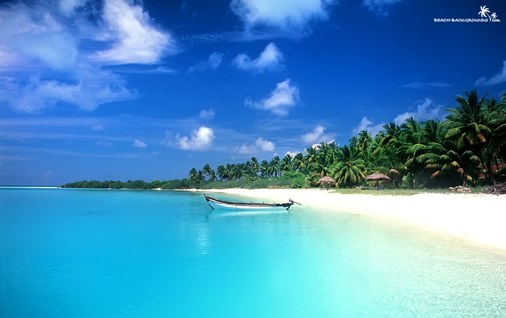
A hot season retreat for Margao’s moneyed middle classes since long before Independence, Colva is the oldest and largest of South Goa’s resorts.
Anjuna Beach
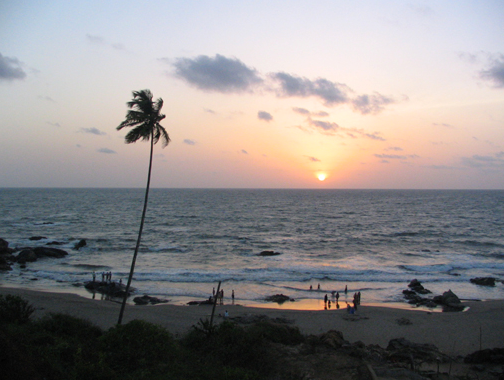
With its fluorescent painted palm trees and infamous full moon parties, ANJUNA, 8-km west of Mapusa, is Goa at its most “alternative”.Anjuna is the venue for rocking rave parties, specially during christmas and new year.
Sri Devaki Krishna Temple
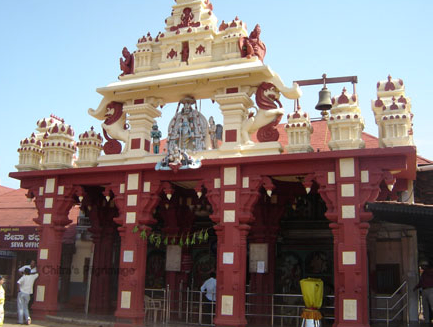
3-km away from Banastari Bridge on Panaji-Ponda Road is situated the noteworthy temple dedicated to Devaki Krishna at Marcel. The garbha griha of the temple houses beautiful images of Lord Krishna along with Devaki.
Sri Kamakshi Temple
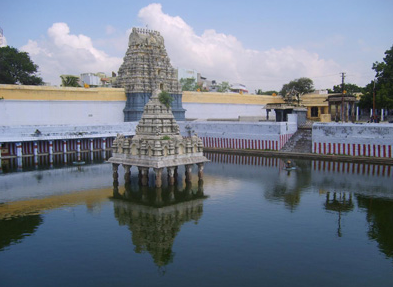
About 12-km from Kavalem is situated another important religious monument which is dedicated to Sri Kamakashi.The deity is believed to have been brought from Kamakhya in Guwahati where the goddess actually resides.
GETTING THERE:
Goa by Air – Dabolim is the main entry point for Goa situated at a distance of around 29 km from Panaji on the coast near Vasco da Gama. Most domestic airlines operate in Goa apart from chartered private airlines operating from UK and Germany. There are many direct flights from Delhi and Mumbai daily.
Climate:
The climate of Goa can, in general terms, be summed up in one word: coastal. There are no extremes in temperature and no clear demarcations from one season to the other except for the monsoon. The monsoons are the main feature of the climate of Goa. The ideal time to visit this mesmerizing state should be between mid July to late September or from the month of November to February. Since the climate is most pleasant during these months. Temperature and Rainfall in Goa:
- Monsoon: July to End September (26 inches)
- Winter: Late November to Mid-February (Min. 3″C-Max. 11″ C)
- Summer: Mid-March to End of June (Min. 25″C – Max. 45″C)
About Bangalore:
Bangalore, Bengaluru is the capital of the Indian state of Karnataka. Bangalore is nicknamed the Garden City and was once called a pensioner’s paradise. Today as a large city and growing metropolis, Bangalore is home to many of the most well-recognized colleges and research institutions in India. Numerous public sector heavy industries, software companies, aerospace, telecommunications, and defence organizations are located in the city. Bangalore is known as garden city because of its beautiful gardens. Bangalore is also known as the Silicon Valley of India because of its position as the nation’s leading IT exporter. A demographically diverse city, Bangalore is a major economic and cultural hub and the second fastest growing major metropolis in India.
Places to Visit:
Vidhana Soudha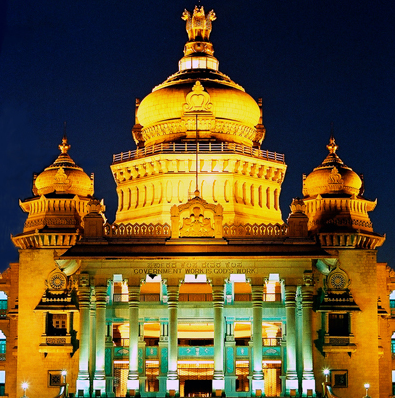
A magnificent building of the Neo-Dravidian style, houses the State Legislature which was conceived and executed by Kengal Hanumanthaiah, the former Chief Minister of Karnataka in 1956.
Places to Visit:

One of the oldest museums in the country, established in 1886, has a unique collection of sculptures, inscriptions, paintings, icons and also some relics from Mohenjodaro.
Cubbon Park
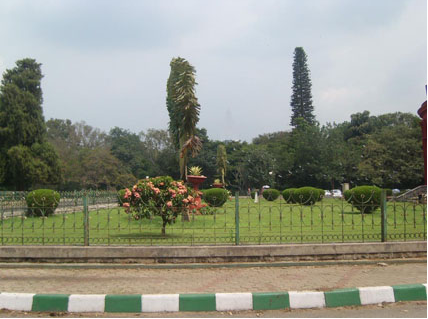
Spread over 300 acres of land, this park serves as the lung space of the ever growing Bangalore city. Designed by Lt. General Sir Mark Cubbon, in 1864, is dotted with statues, fountains and also has a library within its premises.
The Jawaharlal Nehru Planetarium
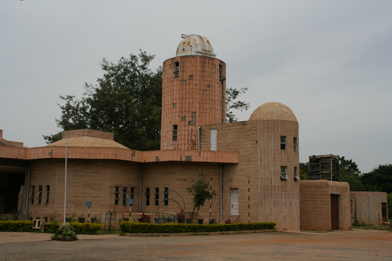
The sky theater with a dome of fifteen meters in diameter attracts all the amateur astronomers and the commoners to this Planetarium.
The Bull Temple

Built by Kempe Gowda, this temple is famous for a huge monolithic bull that stands 4.5m tall and 6m long.
Lal Bagh Gardens

This expanse of greenery, which was laid out by Hyder Ali and Tipu Sultan in the 18th century, is one of India’s most beautiful botanical gardens. Within the Gardens there is a beautiful lake with water spread over an area of 1.5 sq kms.
Nandi Hills
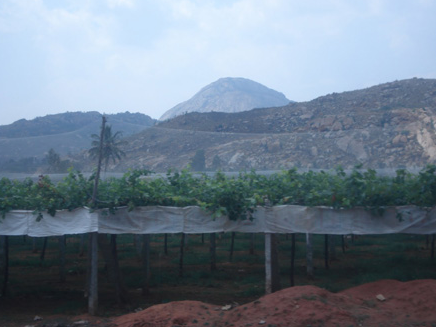
This range of craggy hills holds the shimmering Amrita Sarovar Lake and is a popular health resort today. A flight of 1,175 steps leads from the base of the hills to the top.
Shiva Statue
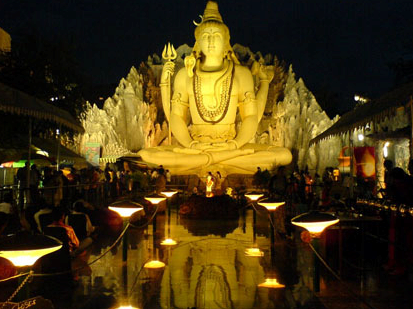
The Shiva Statue is 65 feet and depicts Lord Shiva who is seated in Padmasan or Lotus position. This is the largest Shiva statue in India.
ISKCON Temple Complex
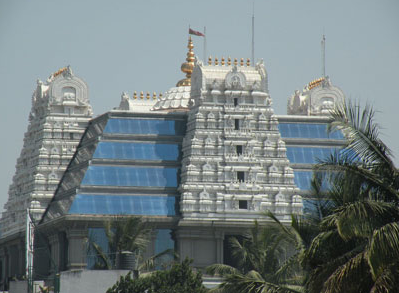
A perfect and breathtaking blend of modern and traditional south Indian temple architecture, the ISKCON temple should be a must-see on your itinerary
Ulsoor Lake
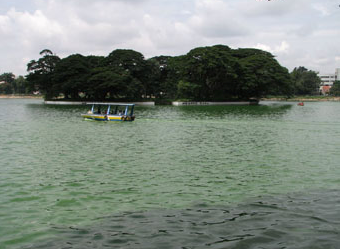
Right in the heart of the city, is this lake constructed by Kempe Gowda, which also has many tiny islands.
Ulsoor Lake

Right in the heart of the city, is this lake constructed by Kempe Gowda, which also has many tiny islands.
The Bangalore Palace
Built way back in 1887 by Chamaraja Wodeyar, the Bangalore Palace is inspired by the Windsor Castle
GETTING THERE:
Bangalore by Air – Bangalore is well connected by Air, Rail and Road from all parts of the country. The International Airport at Devanahalli has become operational, Air India operates direct flight to/from London, New York, Chicago, Paris, Dubai, Abu Dhabi, Riyadh, Jeddah and Kuwait providing immigration and customs clearance facilities. Lufthansa (German Airlines) also operates direct flight from Frankfurt, British Airways from London Heathrow, Air France operates directly from Paris, Malaysian Airlines from Kuala Lumpur and Singapore Airlines from Singapore. Around 420 flights land and take off in Bangalore each week, of which 50 are international ones.
Bangalore by Rail – Bangalore has two major stations: Bangalore City and Bangalore Cantonment. The City station is the Main Station where all the trains depart and arrive to and from all parts of the country. It is located in the heart of the City at the Majestic area.
Bangalore by Road – Bangalore has a well-maintained bus-stand situated right opposite the railway station in the Majestic Area, which makes it easier for the passengers alighting from trains to catch buses to nearby cities. The Bangalore Metropolitan Transport Corporation (BMTC) handles all the buses plying within the city while the Karnataka State Road Transport Corporation (KSRTC) operates the buses within the state as well as outside. There are buses at regular intervals to almost all places within the Karnataka State and also to neighboring states. A number of private agencies also run bus services to places across the country. The other transport corporations of the neighboring states also operate from and to Bangalore.
In addition to the various state buses, numerous private companies offer more comfortable and more expensive buses between Bangalore and the other major cities in central and southern India.
Climate:
Bangalore is situated in the Deccan Plateau, with an average elevation of 920 m above sea level. Due to its elevation Bangalore enjoys a pleasant and equable climate throughout the year. The highest temperature recorded is 38.9 °C (102.0 °F) on May 22, 1935 and the lowest is 7.8 °C (46.06 °F) in 1884. Winter temperatures rarely drop below 12 °C (54 °F) and summer temperatures seldom exceed 38 °C (100 °F).
About Chennai:
Chennai (formerly known as Madras) or Madarasapatinam, is the capital city of the Indian state of Tamil Nadu, located on the Coromandel Coast of the Bay of Bengal. Chennai’s economy has a broad industrial base in the automobile, computer, technology, hardware manufacturing and healthcare industries. The city is India’s second largest exporter of software, information technology and information-technology-enabled services A major chunk of India’s automobile manufacturing industry is based in and around the city. The city is considered a center for Carnatic music and is the host of Madras Music Seasons. It is well known for the Marina Beach which, at 14 km long, is considered India’s longest urban beach.
Places to Visit:
“Once a fishing village, Chennai, is now a sprawling capital city of Tamil Nadu. People of Chennai are deep rooted in their cultural moorings and traditions, even though modernity has its own impact.
Mahabalipuram
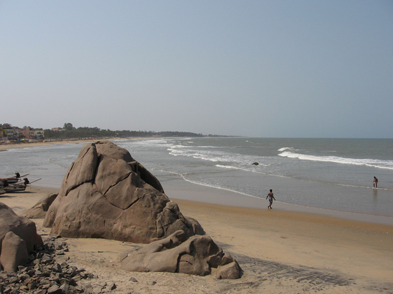
This is located at a distance of 55kms, and globally acclaimed for the town Mahabalipuram. The seaside view is unforgettable. If you move ahead 15kms further you would reach Tirukkalikundram, which is a well known pilgrim centre that houses a temple atop the hill dedicated to the Hindu Lord Shiva.
Kanchipuram
In addition to Mahabalipuram and Chennai, Kanchipuram too forms the popular Golden Triangle in the Coromandel Coast. The place is world famous for the artistic craftsmanship exhibited by the Kanchi weavers. They are the makers of what popularly known as best variety of silk fabric. The city also ranks as one amongst the seven sacred Indian sites
Covelong
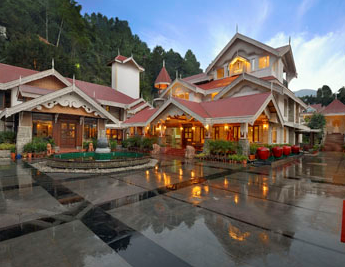
This is one place that allows the tourists to experience the intriguing history of Tamil Nadu in totality. Covelong is filled with churches, old forts, lavish beaches and mosques. The Fort in the recent times has been transformed into an opulent beach resort.
Rameswaram
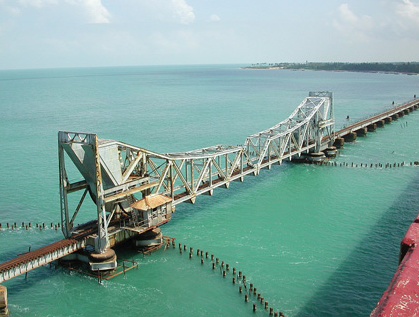
An island having a conch shape located at the Gulf of Mannar, Rameswaram is a sacred site for the Hindus. This is situated near to Madurai.
Kanyakumari
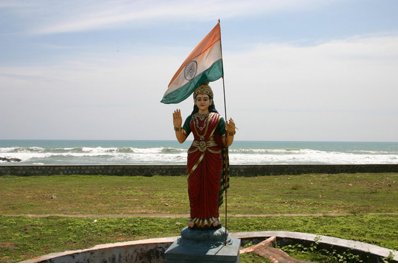
Known as India’s “land’s end”, Kanyakumari offers stunning views of the sunset and sunrise along the horizon. The temples located here are the major points of interest.
Pondicherry
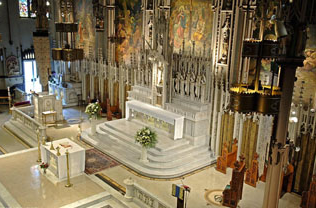
This town is highly influenced by the French rule. It is also well known as Sri. Aurobindo once resided here. The various tourist attractions here include the museums and churches.
Crocodile Bank
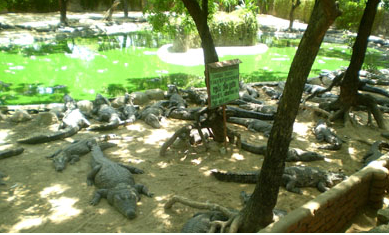
Being situated close to Romulus Whittaker, Mamallapuram this famous crocodile research and breeding centre attracts one and all. You can spot numerous and various species of African and Indian alligators and crocodiles that are bred in custody
Tirupati
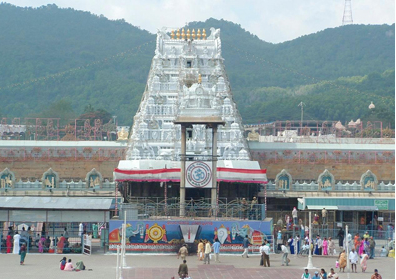
Tirupati is said to be the house of the “Lord of Seven Hills” and possesses a famous shrine that the country has.
Vandalur
Anna Zoological Park is situated here and is considered to be the biggest in South Asia. You will find over here a rich variety of birds, mammals and reptiles
Vedanthangal
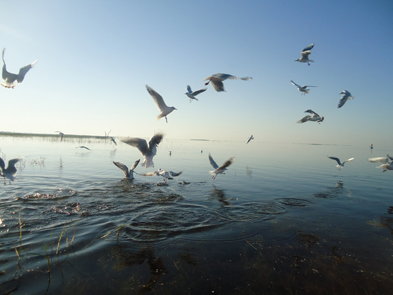
This is known as one of the biggest bird sanctuaries present in India. It is a beautiful park with a lake that is visited by over 1, 00,000 migratory birds annually mostly during the months of November and December.
GETTING THERE:
Chennai by Air – Chennai has an international airport which is located at a distance of 7 km from the main city. The airport caters to al the domestic and international passengers coming to the city. There are a number of domestic flights to and from Chennai which connects it to all the major cities within the country. Besides, there are host of international airlines which operate from the international terminal and links it with the important world cities with the city.
Chennai by Rail – Chennai has two railway stations, Chennai Cenral and Egmore Station. Chennai Central is the bigger one of the two and runs on broad gauge, connecting with all the major cities and towns of India such as New Delhi, Mumbai, Calcutta, Cochin, Thiruvananthapuram, Hyderabad, Bangalore, Coimbatore, Lucknow, Guwahati . The Egmore Station houses a number of meter gauge and broad gauge trains, which originate from here and ply to different destinations within the state as well as to the neighboring states. Chennai Central links North and West India, while Egmore links South India.
Chennai by Road – Chennai is also well connected via road. It is linked with all the important places in Tamil Nadu as well as India with the help of a good network of roads. There are even government bus services which operate within Tamil Nadu and other states. These buses operate from Chennai Mofussil Bus Terminal at Jawaharlal Nehru Salai, Koyembedu. It is considered to be the largest bus station in entire Asia.
Climate:
Chennai experiences a tropical climate, specifically a tropical wet and dry climate. The city lies on the thermal equator and is also on the coast, which prevents extreme variation in seasonal temperature. The weather is hot and humid for most of the year. The hottest part of the year is late May to early June, known locally as Agni Nakshatram (“fire star”) or as Kathiri Veyyil, with maximum temperatures around 38–42 °C (100–108 °F). The coolest part of the year is January, with minimum temperatures around 18–20 °C (64–68 °F). The lowest temperature recorded is 15.8 °C (60.4 °F) and highest 45 °C (113 °F) The average annual rainfall is about 140 cm (55 in). The city gets most of its seasonal rainfall from the north-east monsoon winds, from mid-October to mid-December. Cyclones in the Bay of Bengal sometimes hit the city.
About Kerala:
Kerala is an Indian state located on the Malabar coast of south-west India. It was created on 1 November 1956 by the States Reorganisation Act, and it combined various Malayalam speaking regions. Kerala is a popular tourist destination for its backwaters, yoga, Ayurvedic treatments and tropical greenery. Referred as the “Spice Garden of India”, Kerala is a beautiful state with an excellent landscape of palm-lined beaches, thick jungles, plantation-covered hills, and enthralling rivers and lakes. It is considered to be one of the cleanest and the most peaceful parts of India, with the state remaining a major source of India’s bananas, rubber, cardamoms, coconuts, cashews, and ginger. The National Geographic Traveler has quoted Kerala as India’s most verdant state with one of the world’s 50 “must see” destinations. “The god who made Kerala had a green thumb”, true to the popular Malayali saying, Kerala’s rich resources have long attracted visitors from across the oceans. It is in fact here that the first seafarers set foot on Indian soil.
Places to Visit :
Better known as God’s Own Country, Kerala is a heavenly portrait splashed with myriad of enchanting hues. From the lagoons & backwaters that meander through the enchanting landscapes, to the rich and colourful culture & heritage that weave a tapestry of tourism delights, Kerala is a dream holiday destination of India.
Trivandram
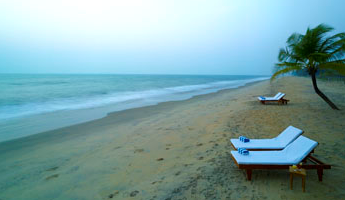
The capital of the state, it is a hub of tourist destination. Trivandram (known as Thiruvananthpuram) is located west to the Arabian Sea, is worth seeing place in the gods own country. It is notable for its internationally renowned beaches, historical monuments, backwater stretches, and scenic view.
Kovalam

It is situated about 12 km from south of Trivandram, covers of the two palm-fringed beaches separated by rocky headlands. The most notable place to explore the beauty of place is Padamanpapuram palace built fully out of wood.
Vrakala
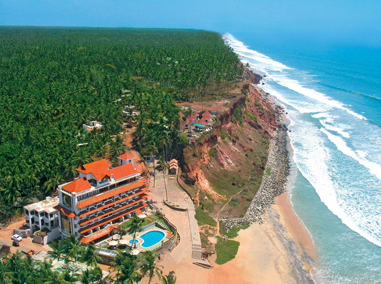
The small town is notable for the Janardhana Swamy temple, holds legends pf two thousand year old. The residents of the town celebrate Arattu festival in respect of their ancestor. Further, the place is known for its sun, sea and calm beaches.
Kollam
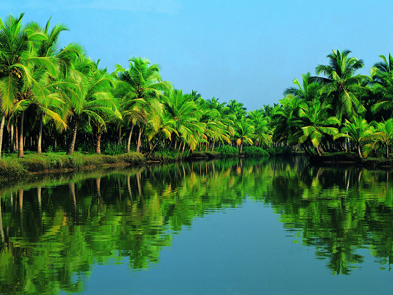
Kollam or Quilon, lies 155 km south of Cochin, is worth seeing place. It is known for its old timber buildings and red clay tile roofing which represents peculiar Kerala architecture.
Allepey
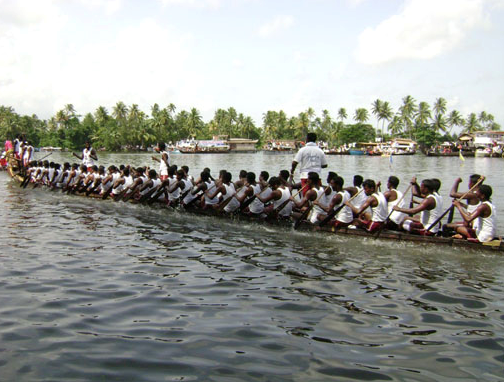
Regarded as the Venice of East, It is surrounded by canals, coconut palms. And the most striking feature of the place is Snake boat race festival, celebrated in second week of August, attracts thousands of tourist from all over the world.
Kumarakom
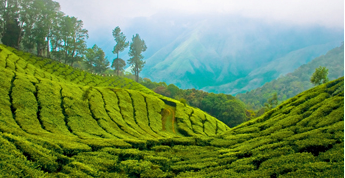
Located around Vembnad Lake, it is considered as gateway to backwaters of Kerala. The island is perfect place for romantic and private holidays.
Munnar
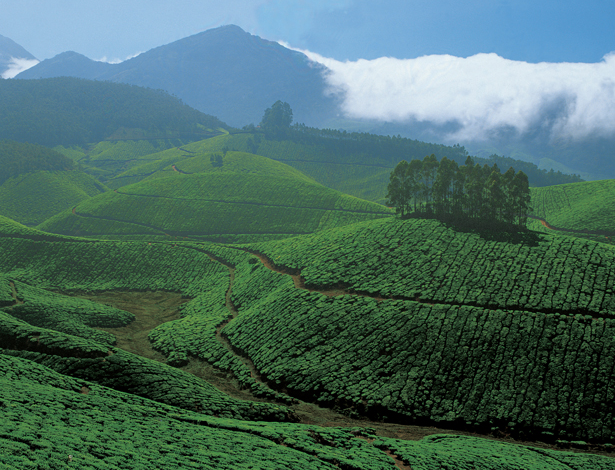
One of the most sough-after tourist destination in Kerala, Munnar is paradise for nature lovers. The place is notable for its scenic view, extensive tea plantation and also sizable population of wildlife.
Kozhikode
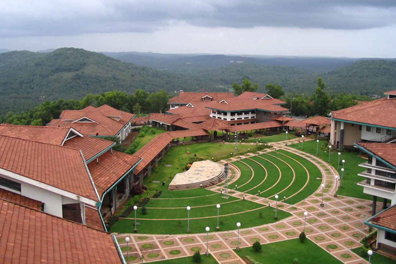
The most important commercial hub of Kerala, Kozhikode or Calicut is bestowed with lush green country side, pristine beaches, historical monuments, wildlife sanctuaries, rivers, hills and vibrant culture and warm. Apart from these, there are so many visiting places such as Kannur, Wayanad, Kasrgpode, and Palghat lies in the green paradise on Earth, Kerala.
GETTING THERE:
Kerala by Air – The quickest and comfortable way to get to Kerala is by air and airlines connect all the important cities in India. Kerala with three international airports at Thiruvananthapuram, Kochi and Calicut is well connected with important domestic and international airports.
Kerala By Rail – The other means to get to Kerala is the train that connects all the important cities in the country. The trains offer services that range from luxurious to budget catering to the needs of the travelers. One can also get to Kerala by road as there are plenty of bus services in Kerala linking all the major cities and towns. You can choose according to speed or comfort level from a range of super- fast, super- express or luxury buses run by private bus companies and state transport departments as well.
Climate :
The climate of Kerala is tropical like most parts of India. Due to close proximity to sea, the temperature of Kerala remains equable for most parts of the year. The state does not have a continuous dry spell, with the summers lasting from mid February to mid May. Kerala receives most of the rainfall from North East Monsoons, which touch the state in mid May and frequently shower till early September. Besides the North East Monsoons, Kerala also receives showers from the South East Monsoons which knock in the last week of September and stay till early November. The winter season in Kerala, lasting from mid October to early February, is mild as the temperature drops a bit but the weather is never too chilly in Kerala.
About Hyderabad:
Hyderabad is the capital of Andhra Pradesh (AP) and the fifth largest city of India. While AP is known as the most IT savvy state in India, Hyderabad is emerging as a major center for IT exports. It’s share in Indian IT exports is about 12%. The city is galloping towards its dream of becoming the Silicon Valley of India. Today, it is home to many international companies and global IT majors including Microsoft, CA, Oracle, IBM, Dell, Infosys, Wipro, TCS, Satyam and others. Apart from IT, Hyderabad is also emerging as a leader in the pharma, insurance and tourism sectors. In addition, it also houses the state ministries, defense undertakings and research and development organizations. The city has become a constant fixture of the itinerary of global leaders and business delegates, and has played host to distinguished personalities such as George W Bush, Bill Gates, Bill Clinton, and Tony Blair. The city’s cosmopolitan way of life that envelops in its wake, the ancient and the contemporary, upcoming and thriving discothèques, pubs, theme villages, snow park and Go-Karting is sure to leave everyone charmed.
Places to Visit:
Hyderabad is the ideal starting point to begin a tour of South India. The museums, temples, lakes, gardens, culture and crafts of South India wait to be discovered by you, as you arrive in Hyderabad.
Charminar
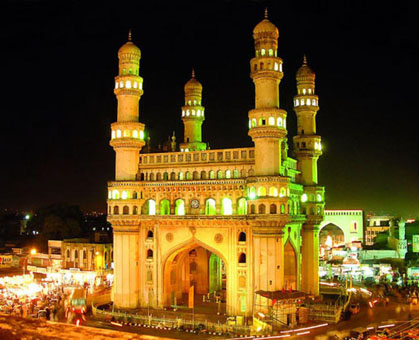
Literally “Four minarets”, this structure was built at the very spot at which Quli Qutb Shah prayed for the end to the plague epidemic. The Charminar has long been the icon of Hyderabad. The towers rise to a height of 48.7 m above the ground.
Mecca Masjid
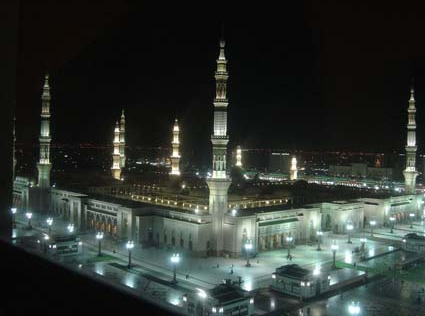
Mecca Masjid is one of the oldest mosques in the city and easily the biggest. Muhammed Quli Qutub Shah began building it in 1617 under the supervision of Mir Faizullah Baig and Rangiah Choudhary. Mughal emperor Aurangzeb completed the construction in 1694. The mosque is a granite giant with awe-inspiring innards.
Chowmahalla Palace
Situated near Charminar, it was the seat of the Asaf Jahi dynasty where the Nizam entertained his official guests and royal visitors.
Falaknuma Palace

Built by Nawab Viqar al-Umra in 1872, Falaknuma is a stunning piece of architecture and the most opulent of the Nizam’s palaces. The interior is particularly impressive and features the works of Florentine sculptors and a 100-seater Dining Table. The palace has been converted into a hotel run by the Taj group.
Golconda Fort

The Golconda Fort was the capital of the Qutb Shahi kingdom. Set aside a minimum of 2 hr to do justice to your visit — the outer wall measures 10 km. Learning a little about the fort ahead of time is recommended as it is easy to get confused or lost in the massive space.
Qutb Shahi Tomb
The Qutubshahi mosques in Hyderabad are so named because they were built by the Qutubshahi dynasty. Most of them were built by Quli Qutb Shah, the founder.
H.E.H The Nizam’s Museum

Home to the famous wardrobe of Mahbub Ali Pasha, who is said never to have worn the same thing twice. It is the world’s longest wardrode, built in two levels with a hand-cranked wooden lift(elevator) in place. This occupies the entire length of one wing of the palace.
Moula Ali Dargah
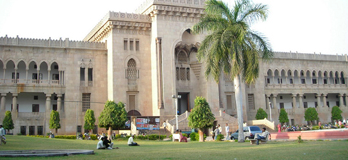
400 stairs brings you to a place of worship built by the Asif Jahis. The Moula Ali Dargah was built in the memory of Hazrat Ali, the son-in-law of the Prophet Muhammad. Legend has it that Yakoob, a eunuch in the court of Ibrahim Quli, went to the hill after he saw Hazrat Ali seated on it. To his surprise, he saw the impression Ali’s palm on a stone, which he had dreamt. He had the impression cut out and installed in a shrine. Ibrahim Shah later built a mosque beside the dargah.
Paigah Tombs, Santoshnagar
These tombs belong to the ‘Paigah’ nobles (tied by blood and marriage to the Nizams) and are about 200 years old. These unique lime and mortar tombs are beautifully carved and have marble inlay work on them.
Purani Haveli, Dewandevdi
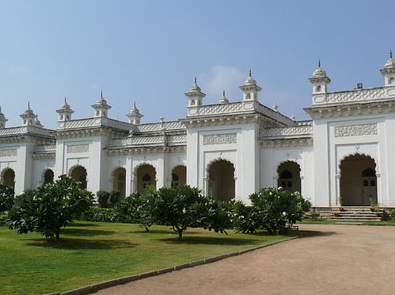
Originally, the palace of the Nizam’s Prime Minister, later it was renovated and became the quarters of the Nizam’s son. It is a U-shaped complex with a single-storeyed building in the European style.
Salar Jung Museum
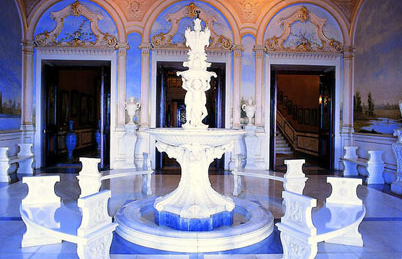
This collection belonged to the Salar Jungs, Prime Minsters of Hyderabad, but has been augmented since. The collection includes articles mostly from medieval and modern times, with a concentration of articles from the Islamic era. The western wing on the second floor is interesting. It contains paintings, furniture and other objects that the Salar Jung got from the West. The collection of Nizam jewellery is displayed only on special occasions. Free guided tours lasting two hours each are available at scheduled times, four times a day.
GETTING THERE:
Hyderabad by Road – Hyderabad is connected to the rest of the country by National Highways—NH-7, NH-9 and NH-202. Hyderabad is also well connected to the remaining parts of the state. Like other cities, Hyderabad suffers from traffic congestion. Completion of the Inner Ring Road and construction of the Outer Ring Road encircling Hyderabad city is also underway and is touted to make travel in the city easier. Many flyovers and underpasses are also being constructed to ease traffic congestion in the city.
Hyderabad by Rail – Railways were first introduced in the city in the year 1869 with the commencement of Secunderabad–Wadi line of Nizam’s Guaranteed State Railway. Secunderabad Railway Station is the headquarters of the South Central Railway zone of the Indian Railways and is the largest railway station serving Hyderabad. The other major railway stations serving the city are Hyderabad Deccan Station (Nampally) and Kachiguda Railway Station. These stations provide connectivity within the city and the rest of the country.
Hyderabad has a light rail transportation system known as the MultiModal Transport System (MMTS) which offers connectivity between rail and road transport for the facility of the commuters. MMTS provides connectivity to most of the major parts of the city, and is a suitable alternative for those who want to avoid road traffic.Hyderabad Metro is the proposed rapid transit for the city. The deadline of the bidding process has been delayed consistently.
Hyderabad by Air – There has been an unprecedented increase in the number of passengers leading to increased air traffic. The Airport at Begumpet was unable to cope up with the situation and was shut down on 2008-03-22. The new Rajiv Gandhi International Airport was opened in March 2008 by Sonia Gandhi at Shamshabad, southwest of the city. The airport has the longest runway in India and caters to the high passenger and cargo volumes it experiences. There are flights to many destinations, both domestic and international from this airport.
The PV Narasimha Rao Expressway was constructed at an elevated level from Mehdipatnam to Rajendranagar along with an underpass and trumpet interchange for providing dedicated high speed travel to the airport. It is the longest flyover in India. There are three wide roads leading to the new airport from the city and modern taxis and buses can shuttle passengers between the city and the airport. The Nehru Outer Ring Road serves as an expressway between Gachibowli and Shamshabad.
Climate :
Hyderabad has typically a hot climate with the temperature exceeding 40 C in the summers. Winters are, however, mild and more tolerable. The maximum temperature in summers is somewhat between 40 C and 43 C. In the month of winters it is between 20 C to 24 C. The mercury may lower down to its minimum of 13 C in the month of December. South west monsoons sets in from June to September. There is plenty of rainfall during this period and accompanied by high humidity. The same is quite low during winter months.
About Nagpur :
Nagpur is a city and winter capital of the state of Maharashtra, the largest city in central India and third largest city in Maharashtra after Mumbai and Pune. The capital of Vidharbh. In addition to being the seat of annual winter session of Maharashtra state assembly “Vidhan Sabha”, Nagpur is also a major commercial and political center of the Vidarbha region of Maharashtra, and is also famous throughout the country as “Orange City” for being a major trade center of oranges that are cultivated in the region. In addition, the city also derives political importance from being the headquarters for the Hindu nationalist organization RSS and an important location for the Dalit Buddhist movement. Nagpur lies precisely at the center of the country with the Zero Mile Marker indicating the geographical center of India. The British East India Company took over Nagpur in the 19th century and made it the capital of the Central Provinces and Berar. After the first reorganization of states, the city lost its capital status but according to the informal “Nagpur Pact” between political leaders it was made the second capital of Maharashtra.
Places to Visit:
There are quite a few Nagpur tourist attractions in the city of Maharashtra. These places are quite popular among the tourists who come to visit this city of India. Some of the major places of interest in the city are the Balaji Mandir, the Ambazari Lake, the Seminary Hill and the Maharaj Baug and Zoo.
Adasa
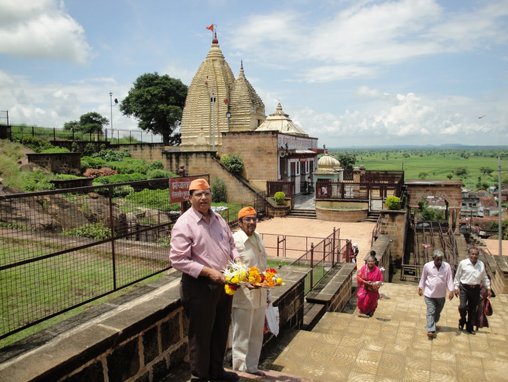
Adasa is located at a distance of 45 km from Nagpur. This small village has a plethora of ancient and magnificent temples. There is also a Ganapati Temple here, which is worth to be visited. The idol of the Lord is a single stone, set up to facilitate easy worship for the devotees. This place is easily accessible from Nagpur with many buses are plying from Nagpur, Kamleshwar and Saoner
Khekranala
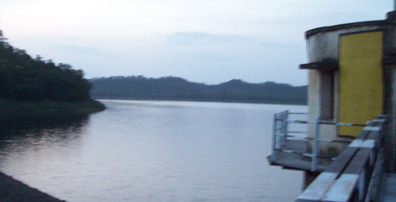
Khekranala is situated at a distance of 55 km from Nagpur. There is a beautiful dam at this place. The location of the site is so greenery and peaceful, as it is in the range forest of Khapra. Dense foliage covers the water reservoir.
Markanda
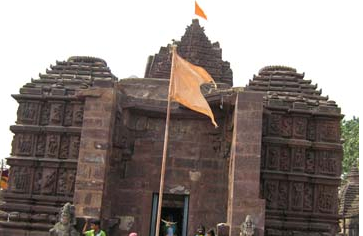
Markanda is a cluster of nearly 24 temples, which resembles the architecture of the Khajuraho temples. This small town is located on the left bank of Vainganga River, which is famous as a religious site. The place derives its name from Sage Markandeya.
Dhapewada
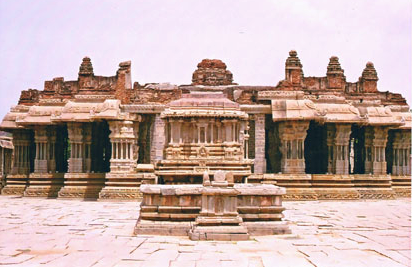
Dhapewada Lake is 8 km from Ramtek and 60 km from Nagpur. This place has a small temple of Vithoba lies peacefully on the banks of the Chandrabhaga River. It has a variety of water sports to offer as well. This place is known to be the Pandharpur of Vidarbha. Khindsey Lake is another beautiful water body set amidst the green stretch of the Ramtek hill. This place is an ideal picnic spot.
Nagardhan
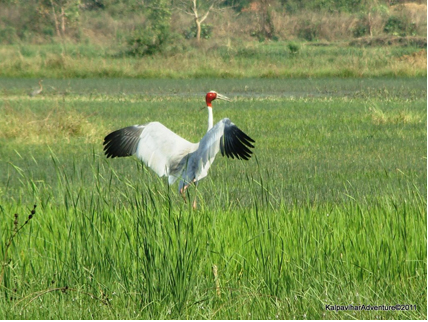
Nagardhan too has a fort, which is believed to be constructed by the Bhonsles. Gifted with an abundance of wild life, Nagzira has a wildlife sanctuary resting in natural domains that are a harmonious combination of lush greens and water bodies. Gaur, sambar and deer can be seen here.
Nawegaon Dam
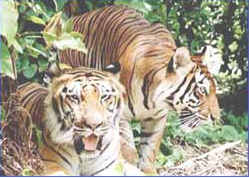
Nawegaon Dam is the most popular forest resort of Vidarbha. The resort provides different adventure sports. Kolu Patel Kohli built this dam at the start of the 18th century. A placed lake adorns the hub of the hill ranges. There are also watchtowers to catch the wildlife in action. There is a deer park near the dam as well called Dr. Salim Ali Bird Sanctuary, along with three fascinating gardens and children’s park.
Ramtek
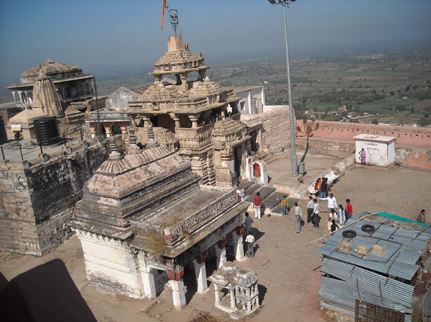
Ram temple, which is more than 600 years old and Jain Temple, which has some beautiful carvings and sculpture are the main attractions of Ramtek. Ramtek is at a distance of 50 km from Nagpur. Lord Rama, Sita and Laxman were believed to be visited this place. Kalidas composed Meghdoot in this place.
Pavnar
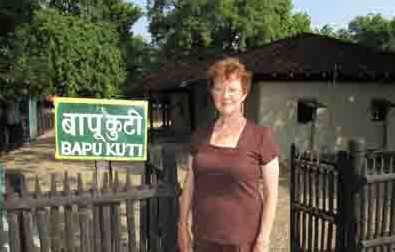
Strategically located on the verge of the Dham River, Pavnar is of extreme historical importance. Its name derived from a Rajput ruler Pawan. It forms one of the most prehistoric colonies in the district. Gandhi Kuti and Paramdham Ashram of Vinobaji are the attractions of this place.
GETTING THERE:
Nagpur by Rail – Due to its central location in India, the Nagpur Railway Station is an important railway junction and a transit terminal for trains that connect the country lengthwise and breadth wise, especially trains connecting India’s major metropolises, Mumbai to Howrah-Kolkata, Delhi and Jammu to Chennai, Hydrabad, Bangalore and Kanyakumari in the South, as well as western cities such as Pune and Ahemedabad. The city is the Divisional Head Quarters for the Central Railway and South East Central Railway Zone of Indian Railways.
Nagpur by Road – Nagpur is also a major junction for roadways as India’s two major national highways, Kanyakumari-Varanasi (NH 7) and Hajira-Kolkata (NH-6), passing through the city.One more highway number 69 connect Nagpur to Obaidullaganj near Bhopal. Nagpur is at the junction of two Asian Highways namely AH43 Agra to Matara, Sri Lanka and AH46 connecting Kharagpur, India to Dhule, India. Auto rickshaws operate in most parts of Nagpur and are the main form of hired transport within the city.
The new national highway is being built between Nagpur and Mumbai, alternative to the existing NH 6. This new Nagpur-Aurangabad-Mumbai express highway is build on the national highway basis, though being the state highway, entirely inside the state of Maharashtra. This highway will be a major boost to the under developed regions of Vidarbha and Marathwada in Maharashtra state.
Nagpur by Air – Nagpur’s Air Traffic Control (ATC) is the busiest in India, with more than 300 international flights flying over the city every day in 2004. In October 2005, Nagpur’s erstwhile Sonegaon Airport was declared an international airport and was renamed Dr. Babasaheb Ambedkar International Airport. Country’s first ever international cargo hub, the Multi-modal International Cargo Hub and Airport at Nagpur (MIHAN) is planned on the outskirts of the city.
Climate
Since Nagpur is situated at a considerable distance from any major water body, it experiences a climate that is mainly dry or slightly humid for the major parts of the year. It is only during the monsoon season that high levels of humidity are witnessed by the city. Just like any other city of India, Nagpur also experiences three main seasons – summers, winters and monsoons, and one can see great variation in the seasonal temperatures. Summer season in the city begins around the month of March and lasts till June. Monsoon season in Nagpur usually sets around June, with the arrival of South-westerly monsoon winds, and it receives rainfall till September. Winter season in Nagpur stretches on from November till January, with the minimum temperature going below 10 deg C. This season also presents the best time to visit the city, when you don’t have to worry about dripping sweat and can enjoy yourself completely.
About Pune:
Pune, is the second largest in the state of Maharashtra after Mumbai, and the largest city in the Western Ghats. Once the centre of power of the Maratha Empire, it is situated 560 metres above sea level on the Deccan plateau at the confluence of the Mula Pune is known to have existed as a town since 937 AD. Pune was originally called Punawadi. Chhatrapati Shivaji Maharaj, the founder of the Maratha Empire, lived in Pune as a young boy, and later oversaw significant growth and development of the town during his reign. Today, Pune is known for its educational facilities and relative prosperity. Pune is the cultural capital of Maharashtra. Pune has well-established manufacturing, glass, sugar, and forging industries since the 1950-60s. It has a growing industrial hinterland, with many information technology and automotive companies setting up factories in Pune district. The city is known for various cultural activities like classical music, spirituality, theater, sports, and literature. These activities and job opportunities attract migrants and students from all over India and abroad, which makes for a city of many communities and cultures.
Places to Visit:
Pune, despite being considered a small city, is growing very fast. Some its prominent areas are:
Baner
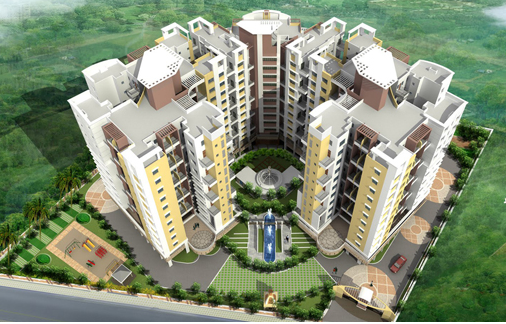
The most fastest developing suburb in the city nowdays located in western region. This area is is close to Hinjewadi IT park and Shree Chatrapati Sports compex. Most convienient gateway to catch Mumabai e-way from the city.
Deccan
Refers to the area around the Gymkhana by the same name. It is the cultural district and houses numerous theaters, art galleries and cinema halls.
Shivaji Nagar
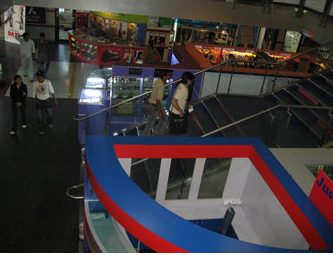
Has a central bus stand and rail stop. The E-Square Multiplex is located here.
Camp
Is the area which refers to Central Pune. At the center of Camp lies Bund Garden, Pune’s largest green patch. Most of the corporate offices and upmarket shopping malls are located here. B T Kawade Road is centrally located residential area located near camp (Eastern Pune).
Shivaji Nagar

Has a central bus stand and rail stop. The E-Square Multiplex is located here.
Koregaon Park
Is located north-east of the Camp area. It is considered to be the poshest suburb and houses the city’s best restaurants. Osho Ashram is here and one finds the maximum number of foreigners here.
